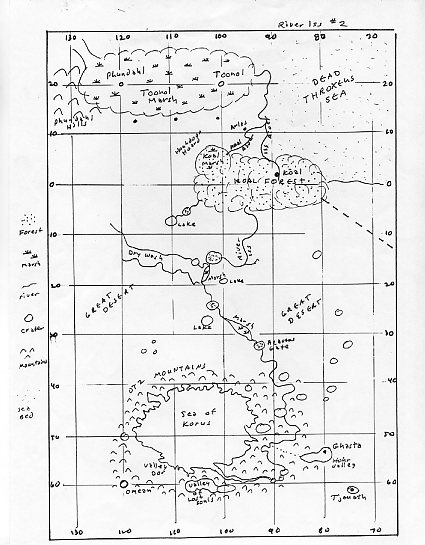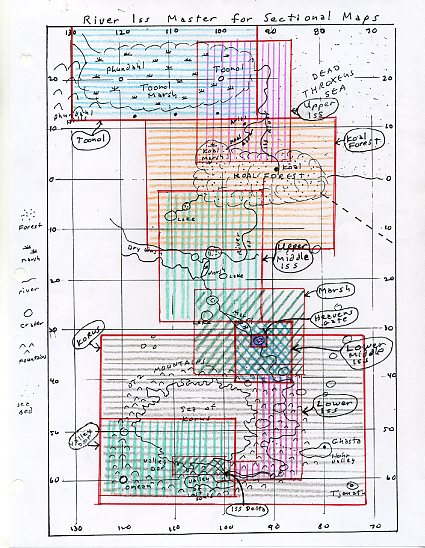

by: Rick Johnson 
PO Box 40451
Tucson, Az.
85717
RikJohnson@juno.com
Back to the Atlas main page.
Back to the Contents page.

The Iss River begins at the eastern end of the Toonolian Marsh, flows generally south along the old coastline to enter the Koalian Forest where it becomes lost to all but the Koalians. Leaving this forest at the south, the Iss flows through a number of craters and valleys and fissures created first by meteoric impact craters then by erosion, thus giving the Iss everything from the grandeur of the Arizona Grand Canyon to the swamps of the Congo to the deserts of the Zimbabwe to the falls of the Nile. Following the Iss is an exercise in beauty that is unparalleled as it carves her way through the Great Southern Desert which is so terrible that even the Green Men avoid it for lack of sustinance.
Long believed to be sacred, this is the river upon which those who follow the ancient Religion of Issus would pilgrimage to the Valley Dor upon the Lost Sea of Korus which was, to the Barsoomian, heaven. Although John Carter destroyed this religion as false, many still believe and occasionally you can still find a pilgrim upon the Iss.
It is believed that there are even lost cities upon this river, some created by pilgrims who turned away from the hardships of travel to seek an easier life. These apostates were forbidden to return to their homes so must survive along the Iss as best they can. Others say that cities and races unknown to modern Barsoom live there, undiscovered.
This, then, is the Iss.

For ease of travel, the Iss may be divided into a number of sections, each unique in its own way.

In ancient Barsoom, Toonol was an open sea bay. Then as the rest of the planet dried, the bay drained and became a swamp. It is this which is the origin of the Iss for without the constant feeding of the Marsh which overflows into the former Throxus, the Iss would dry.
Thus the Iss leaves the Toonol Marsh, draining the Marsh and preventing her from returning to her underwater status. As it enters the Throxus, the Iss returns south to follow the ancient seabed, revealing majestic cliffs on the west bank, dry seabed on the east.

Perhaps halfway down this coastline, a side branch, the Koalian River, forms to enter the Koal Forest at the extreme North West. This section, another impact crater, traps then water to form the Koalian March, not a true swamp but rather a very wet forest.
The main branch of the Iss then follows the coastline until it enters the Koal Forest.
The Koal Forest section.
Little is known of this section for the warriors of Koal guard the forest and the Iss well. Perhaps the Iss branches into dozens of streams, perhaps the Iss continues as one river, perhaps the Iss spreads to feed the entire forest. We simply do not know.

Once the Iss leaves the Koal Forest, it flows generally south for almost 400 miles, weaving from crater to crater, passing dozens or hundreds of dry washes that once fed this river, then she turns west and northwest to enter the first of many of the craters and valleys and fissures that form the Iss herself.
This first is a forest with real trees along the river itself, heavily forested with fern-like moss as you pass further from the water. Then, leaving this crater which is some sixty miles across, you again pass through the Great Desert to enter a long marshy area more than seventy-five miles long and nearly a dozen wide. A hundred miles of desert later you find another forested crater that is said to be the home of naked savages, driven insane by the Iss then some sixty miles later (note all distances are guestimates) lies a water-filled marsh more than a hundred miles long filled with water and reeds.


This section covers the former forest and marsh and describes the Valley of Dorís Gate, a crater valley that has forested croplands on one side, grazing lands on the other, both nations living in peace with each other and avoiding both pilgrim and Thern.
Then after leaving this garden valley, you eventually enter the Otz Mountains, the rim of the impact crater that formed the Sea of Korus.

Entering the Otz Mountains, the Iss meanders through some of the most magnificent canyons that can be imagined, their beauty only a clue to the horrors that await.

It is at the Delta of the Iss where you see the majesty of the Korus Sea and the Valley Dor. It is easy to see how the first pilgrims saw this as heaven after their long journey across half the planet.
Back to the Atlas main page.
Back to the Contents page.

To contact me or to request topics to be covered, send to RikJohnson@juno.com
by: Rick Johnson 
PO Box 40451
Tucson, Az.
85717
